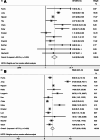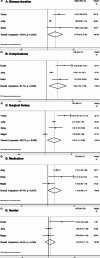Medical radiation exposure in inflammatory bowel disease: an updated meta-analysis
- PMID: 38762503
- PMCID: PMC11102164
- DOI: 10.1186/s12876-024-03264-1
Medical radiation exposure in inflammatory bowel disease: an updated meta-analysis
Abstract
Background: There have been previous studies and earlier systematic review on the relationship between inflammatory bowel disease (IBD) and radiation exposure. With the diversification of current test methods, this study intended to conduct a meta-analysis to evaluate the IBD radiation exposure in recent years.
Methods: Three databases (PUBMED, EMBASE, and MEDICINE) for relevant literature up to May 1, 2023 were searched. The statistical data meeting requirements were collated and extracted.
Results: 20 papers were enrolled. The overall high radiation exposure rate was 15% (95% CI = [12%, 19%]) for CD and 5% (95% CI = [3%, 7%]) for UC. The pooled result found that high radiation exposure rate was 3.44 times higher in CD than in UC (OR = 3.44, 95% CI = [2.35, 5.02]). Moreover, the average radiation exposure level in CD was 12.77 mSv higher than that in UC (WMD = 12.77, 95% CI = [9.93, 15.62] mSv). Furthermore, radiation exposure level of CD after 2012 was higher than those before 2012 (26.42 ± 39.61vs. 23.76 ± 38.46 mSv, P = 0.016), while UC did not show similar result (11.99 ± 27.66 vs. 10.01 ± 30.76 mSv, P = 0.1). Through subgroup analysis, it was found that disease duration (WMD = 2.75, 95% CI = [0.10, 5.40] mSv), complications (OR = 5.09, 95% CI = [1.50, 17.29]), and surgical history (OR = 5.46, 95% CI = [1.51, 19.69]) significantly increased the proportion of high radiation exposure.
Conclusion: This study found that radiation exposure level of IBD patients was high, which revealed the radiation risk in the process of diagnosis and treatment of IBD patients. In the future, longer follow-up and prospective studies are needed to reveal the relationship between high radiation exposure and solid tumorigenesis.
Keywords: Crohn’s disease; Inflammatory bowel disease; Radiation exposure; Ulcerative colitis.
© 2024. The Author(s).
Conflict of interest statement
The authors declare no competing interests.
Figures




Similar articles
-
Utilization of Diagnostic Imaging and Ionization Radiation Exposure Among an Inflammatory Bowel Disease Inception Cohort.Inflamm Bowel Dis. 2020 May 12;26(6):898-906. doi: 10.1093/ibd/izz219. Inflamm Bowel Dis. 2020. PMID: 31560042
-
Radiation exposure in patients with inflammatory bowel disease and irritable bowel syndrome in the years 2001-2011.Scand J Gastroenterol. 2017 Mar;52(3):300-305. doi: 10.1080/00365521.2016.1252945. Epub 2016 Nov 10. Scand J Gastroenterol. 2017. PMID: 27832710
-
Medical radiation exposure in children with inflammatory bowel disease estimates high cumulative doses.Inflamm Bowel Dis. 2011 Nov;17(11):2326-32. doi: 10.1002/ibd.21626. Epub 2011 Jan 13. Inflamm Bowel Dis. 2011. PMID: 21987300
-
Visceral adiposity and inflammatory bowel disease.Int J Colorectal Dis. 2021 Nov;36(11):2305-2319. doi: 10.1007/s00384-021-03968-w. Epub 2021 Jun 9. Int J Colorectal Dis. 2021. PMID: 34104989 Review.
-
Systematic review with meta-analysis: Time to diagnosis and the impact of delayed diagnosis on clinical outcomes in inflammatory bowel disease.Aliment Pharmacol Ther. 2023 Mar;57(6):635-652. doi: 10.1111/apt.17370. Epub 2023 Jan 10. Aliment Pharmacol Ther. 2023. PMID: 36627691
References
-
- Jess T, Gamborg M, Matzen P, Munkholm P, Sørensen TI. Increased risk of intestinal cancer in Crohn’s disease: a meta-analysis of population-based cohort studies. Am J Gastroenterol (2005) 100(12):2724-9. Epub 2006/01/06. 10.1111/j.1572-0241.2005.00287.x. PubMed PMID: 16393226. - PubMed
Publication types
MeSH terms
LinkOut - more resources
Full Text Sources

